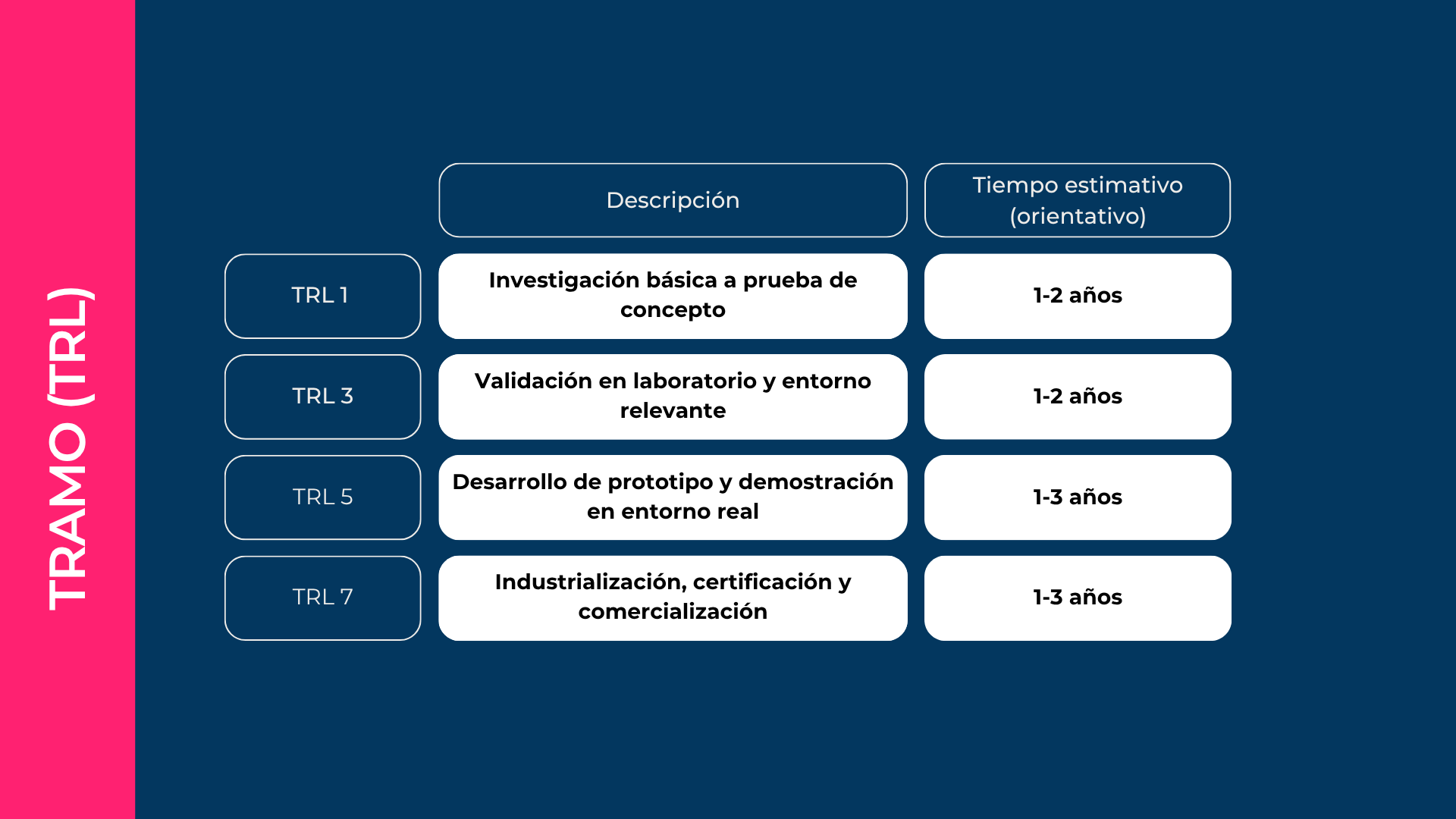
Understanding how the different TRLs are structured and how they relate to the different public support instruments is essential for any startup, scaleup, technology center or innovative corporation that aspires to raise funds for its R+D+i.
What are TRLs?
The TRL scale was initially developed by NASA and has been adopted by the European Commission as a standardized tool for classifying the maturity level of a technology, from basic research to commercial deployment. It is composed of nine levels (TRL 1 to TRL 9), and each represents a specific stage in the technological development lifecycle.
- TRL 1—3: Fundamental research and proof of concept (laboratory, simulation).
- TRL 4—6: Technology validation in controlled and operational environments (functional prototypes, pilots).
- TRL 7—9: Demonstration and industrial exploitation (pre-commercial and full commercialization).
Deepening the Levels of Technological Maturity (TRL)
TRL 1 — Observation of basic principles
What is TRL 1:
It's the earliest level of maturity. Here, the basic scientific and technological principles that can lead to a new technology are identified. This is purely theoretical or conceptual work based on scientific literature or preliminary experimental analyses.
What is not TRL 1:
It does not involve any prototype, concrete experiment or laboratory test. There is no practical evidence, only hypotheses or scientific formulations that have not yet been tested.
TRL 2 — Formulation of the technological concept
What is TRL 2:
In this phase, technological applications or concepts derived from the principles identified in TRL 1 are developed. The desired features and functionalities are beginning to be defined, with some preliminary studies or simple simulations.
What is not TRL 2:
There is as yet no experimental validation or laboratory testing. Nor has any tangible prototype or demonstrator been developed.
TRL 3 — Analytical and experimental proof of concept
What is TRL 3:
The first laboratory experiments or advanced simulations are carried out to validate the technical viability of the concept. This can include testing of isolated components or scale models.
What is not TRL 3:
An integrated prototype is not yet available, nor has the technology been tested in a real or representative environment.
TRL 4 — Technological validation in the laboratory
What is TRL 4:
A technological prototype or basic system is developed and tested in a controlled laboratory environment. Here, components are integrated and their basic functions are validated under simulated conditions.
What is not TRL 4:
The prototype has not been tested outside the laboratory or in an operating environment or environment representative of actual use.
TRL 5 — Validation in a relevant environment
What is TRL 5:
The prototype or system is tested in a relevant or simulated environment that represents actual operating conditions (for example, in a test bench or semi-industrial environment).
What is not TRL 5:
It's not a demonstration under real operating conditions or a field test, just a simulation or controlled environment with realistic parameters.
TRL 6 — Demonstration of the prototype in a relevant environment
What is TRL 6:
A complete prototype or representative model is demonstrated in a real environment or very close to operational reality. For example, a functional pilot that performs the expected tasks under real or close conditions.
What is not TRL 6:
It is not yet an industrial production or implementation, nor is it a final product ready for commercialization.
TRL 7 — Demonstration of the system in a real operating environment
What is TRL 7:
The system or technology is tested in a real operating environment. This involves validation in the field or under end-use conditions, with the prototype functioning as a commercial product.
What is not TRL 7:
It's not a serial production or a product released to the market, just final tests and adjustments.
TRL 8 — Complete and qualified system
What is TRL 8:
The technology is developed, completed and certified for use. All necessary tests have been carried out, it is approved and ready for commercial production.
What is not TRL 8:
It's not just a prototype or pilot system; it already involves preparation for scale manufacturing and launch.
TRL 9 — System tested in real operation
What is TRL 9:
The technology is fully implemented, operating reliably in its real environment and being used successfully commercially.
What is not TRL 9:
It is not just a developed or certified product, but it is in real and continuous commercial exploitation.
This classification allows funding agencies to evaluate Technological risk and determine What financial instruments are most suitable for each phase.
How long does it take to progress between TRL levels?
One of the most frequently asked, and least documented, questions in technological development is How long does it take to go from one TRL to another. The answer, of course, depends on multiple factors: the complexity of the technology, the availability of funding, the technical capacity of the equipment, the existence of validation infrastructures, and market conditions.
However, it is possible to provide a general estimate that serves as guidance for technology startups and SMEs:

These ranges can be extended or shortened depending on the type of technology (for example, software vs. hardware), the applicable regulation (biotech, medtech, energy...), or the possibility of carrying out tests in real environments. In addition, some projects can move faster if they are leveraged on previous results, while others are slowed down by a lack of access to infrastructure or specialized talent.
Important: Funding agencies take these deadlines into account when evaluating the viability of a project. It is key not to oversize technological evolution in a short period of time, as this can lead to skepticism or rejection in the evaluation.
Why are TRLs relevant in public funding?
Many public programs, especially European ones (such as Horizon Europe, EIC Accelerator or Eurostars), as well as national programs (CDTI, ENISA, PERTES, etc.), require companies to indicate the initial and final TRL of their projects. This information allows us to determine if:
- The project is eligible.
- The financial instrument is the right one (grant, loan, equity).
- Can the use of public funds be justified depending on risk and technological applicability.
For example, a project that starts with TRL 2 and reaches TRL 4 is unlikely to have a short-term impact on the market, and therefore, will be more eligible for non-refundable research grants. On the other hand, a development that ranges from TRL 6 to 8 may be eligible for programs more oriented to pre-commercial validation, like the EIC Accelerator or certain lines of the CDTI PID or Missions.
How do TRLs affect technology startups?
For deep tech or knowledge-based startups, such as university spin-offs, accurately identifying and communicating the TRL of their technology is essential for accessing public and private funding. These startups tend to start their development at low levels of technological maturity, typically in TRL 2 or TRL 3, where the technology is in the concept phase or initial validation in the laboratory.
In these early stages, the most appropriate funding options are often public grants aimed at early R&D, such as programs Neotec, Torres Quevedo or ERC Proof of Concept. They can also benefit from technology transfer programs managed by universities or technology centers, which facilitate the validation and initial development of the project.
A common misconception in this area is the overestimation of the real TRL to try to meet the requirements of a call for grants. This not only jeopardizes the eligibility of the project, but it can also cause difficulties during execution and justification before public administrations, affecting the startup's reputation and trust.
To avoid these problems, startups must implement a rigorous internal evaluation process to identify their current and expected TRL following the proposed development. This can be achieved by:
- Detailed mapping of activities and technical results, comparing them with the formal criteria of each TRL level.
- Consultations with technical experts and external validators that help to objective technological maturity.
- Review of technical documentation, prototypes and experimental results to justify the assigned level.
- Clear definition of milestones and deliverables linked to the transition between TRL levels, to demonstrate the technological progress expected during the project.
This realistic evaluation allows the startup to select calls and sources of funding in accordance with their degree of maturity, optimizing the chances of success and ensuring sustainable development aligned with the objectives of the project.
How to Use TRLs Strategically
Beyond their function as a technical classification tool, TRLs should be understood as a strategic guide for decision-making in technological projects. Startups, scaleups and innovative companies that master this logic have a significant advantage when it comes to plan your growth, design your funding and structure your communication with stakeholders.
One of the main strategic uses of TRLs is the mapping of technological phases, which makes it possible to build a clear road map that connects the current state of development with the final goals of commercial exploitation. This roadmap can, and should, be directly linked to funding needs, development schedule, technical milestones and expected validations.
In addition, TRLs allow align the type of public aid with the risk inherent in technological development. This makes it easy to identify appropriate calls at each phase: from research funding for low levels (TRL 1—3), to scaling and commercialization instruments (TRL 7—9). It's not just about opting for more aid, but about apply for the right help at the right time, which increases both eligibility and the success rate.
Another key value of this tool is its usefulness for justify the need for external funding against public entities or private investors. The clarity with which the evolution between TRL levels is defined serves to demonstrate the technical viability of the project, as well as the expected return (technological, social or economic) on the part of the funders.
Finally, TRL-based planning makes it easy to build a coherent discourse to investors and evaluation bodies. In the current context, where more and more processes of due diligence include the review of the real technological state of the project, transparency about the initial TRL and the final objective has become a sign of maturity and professionalism.
Conclusion
TRLs are not just a technical scale: they are a cross-cutting management tool, planning and financing for any technology company. Using them correctly makes it possible to improve development efficiency, maximize the impact of public aid and strengthen the startup's position with investors, administrations and industrial partners.
In an increasingly competitive and regulated ecosystem, understanding and correctly applying TRLs can make the difference between a bankable project and a discarded one. At Intelectium, we accompany startups and companies in this process, helping them to precisely define your technological state, design solid roadmaps and align your funding strategy with your real development needs.
.png)
.png)






















